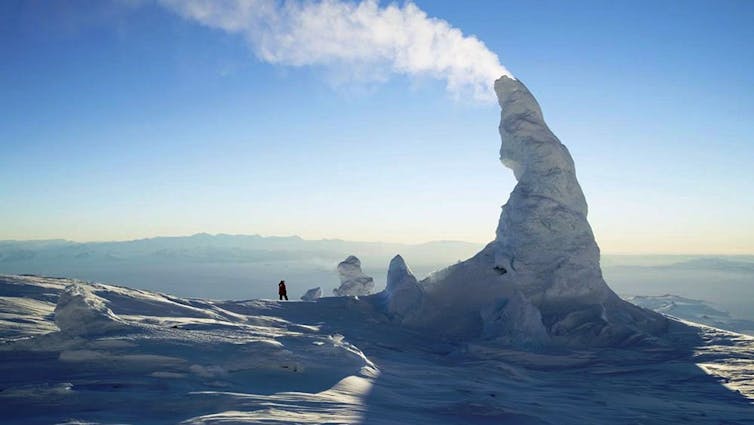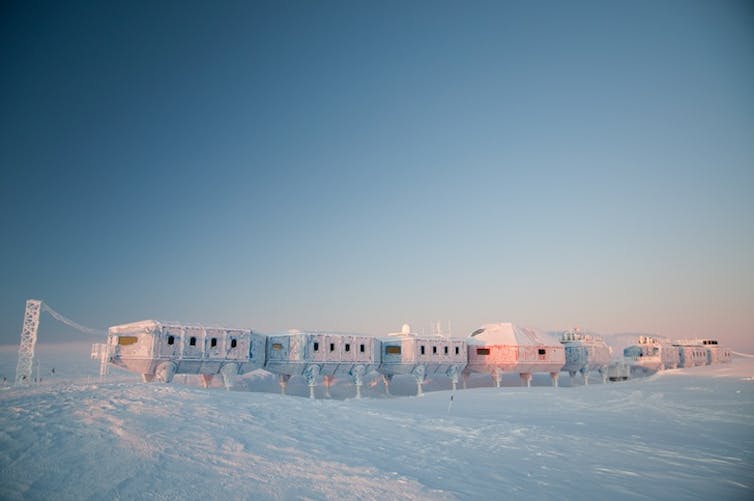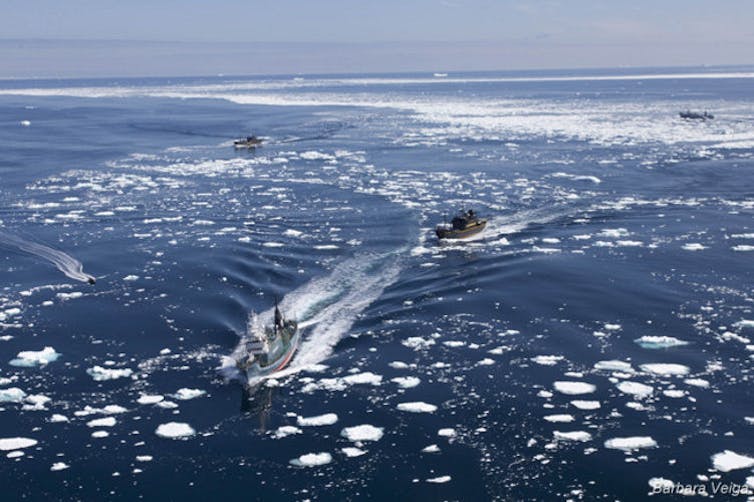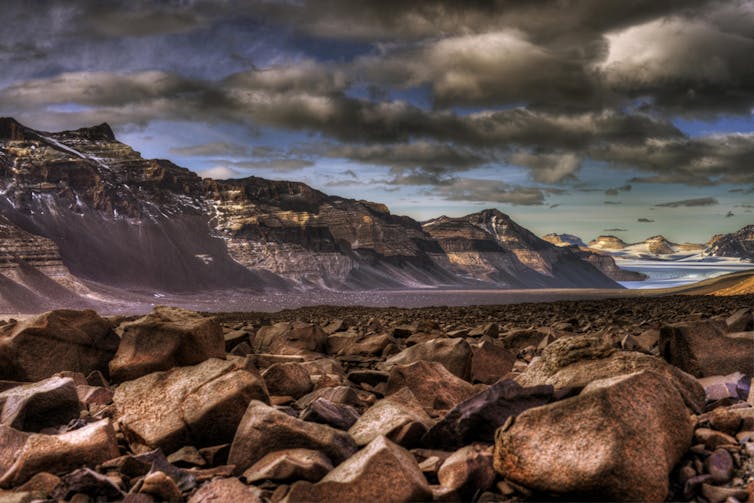The following field notes grapple with the problem of how to understand the emergent polity of Antarctica, and why its break with the language and politics of sovereignty is of global significance. The remarks were prepared for a workshop hosted by the Antarctica Futures project, Sydney Democracy Network, University of Sydney, Tuesday 10th June, 2014.

Antarctopia
This year’s 14th Venice Biennale of Architecture represents, for the first time in its history, a whole continent. The Antarctopia pavilion raises fundamental questions about the subject of sovereignty and Antarctica. Commissioned by artist Alexander Ponomarev and curated by Nadim Samman, the installation is a telling comment on the principle, deeply ingrained in the Biennale, of national pavilions. It’s an exhibition with a difference: a pavilion in motion, knowing no fixed territory, for it is designed as a European interface platform for a future floating Antarctic Biennale, to be displayed in Antarctica in 2015-16, aboard international research vessels. The future Antarctic Biennale (the program notes say) is conceived as a post-national cultural exchange between artists and the continent’s scientists and support staff, a long-term process that brings together leading international architects and artists to explore present and future models of living in Antarctica. Antarctopia seeks to define an ‘expanded Antarctic imaginary’. It even hopes to raise questions about whether there is ‘a new Antarctic man’.
The vision of Antarctopia is more than gender blind. It is a bold reminder that territory, and the people who dwell within it, are never a ‘raw’ given‚ but always come wrapped in (let’s call them) political imaginaries. Yet note the ambivalence in the Antarctopia pavilion’s self-described status as a ‘[trans]national pavilion’. The installation acknowledges that when it comes to Antarctica, sovereignty questions are alive and well. The continent has not shed its skin of nation-centred imagery, and nation-state claims. In this sense, the pavilion is a polemical engagement with architectural nationalism, a counter to the festival’s political commitment to territorial representation. It is an effort to represent a transnational territorial space in a brand new way: an Antarctica community that symbolises a world beyond sovereignty by abandoning state-initiated and state-protected scientific missions, legal practices, symbolic codes and institutional arrangements.
Sovereignty Reconsidered
The spirit of Antarctopia stands at right angles to the popular image of Antarctica as a territorial space ripe for sovereign acquisition by states such as Chile, Argentina or Australia. It calls into question the sovereignty mentality famously articulated by General Augusto Pinochet, during his visit to Antarctica in 1977, when he told French journalists: ‘I have been all over Chile, only this part was missing’; and the same mentality embodied in the 2010 Argentine legislation that makes compulsory the use of a bi-continental map in every government agency, and at all levels of that country’s education system. The examples remind us that in matters concerning Antarctica and its future, sovereignty remains a keyword. But what exactly does the word mean? What can we say about its genealogy? Has the settlement of Antarctica altered, or at least compounded, its range of meanings? Has Antarctica begun to loosen the grip of sovereignty on our political imaginations?

Straightforward replies to these questions are difficult, but we can safely say the category of sovereignty is fundamentally a political concept. It therefore needs to be handled with care. Its theological origins are worth noting. So, too, are its ‘meme’ qualities, its propensity for replication and mutation and time-space variation (an example is the early modern doctrine of popular sovereignty, which is an earthly form of the originally Christian theological doctrine of God as the singular source of political authority). It’s worth remembering as well that the sovereignty principle has triggered bitter controversies about both its meaning and legitimacy. What is nevertheless striking is the resilience of the early modern European doctrine of sovereignty, whose earliest definitions are traceable to such political writers as Jean Bodin, De la république (book 1, chapter 9): ‘All the characteristics of sovereignty are contained in this, to have power to give laws to each and everyone of his subjects, and to receive none.’
This way of political reasoning, repeated by Thomas Hobbes and a thousand subsequent writers, was arguably bound up (Lauren Benton’s A Search for Sovereignty: Law and Geography in European Empires, 1400-1900 points out) with the expansion of European empires through webs of corridors and enclaves, such as sea lanes, rivers, and roads connecting island bases, missions, trading posts, towns and garrisons. The establishment of sovereignty over foreign lands, we can say, took place not merely by force of arms. It also happened through imperial acts of legal possession against the claims of rivals. In addition to legal talk of sovereignty, various other techniques were used to establish sovereign claims: the planting of flags and crosses; the establishment of settlements; the drafting of maps and travel itineraries that eased officials’ navigation within distant realms; and the creation of new governing structures that served as carriers of the sovereignty imaginary.
It was within this historical context that William Blackstone’s well-known and influential Commentaries on the Laws of England (1765-1770; book 1, introduction, section 2) forcefully presented a version of the sovereignty principle. ‘How the several forms of government we now see in the world at first actually began, is matter of great uncertainty, and has occasioned infinite disputes’, he wrote. ‘However they began, or by what right soever they subsist, there is and must be in all of them a supreme, irresistible, absolute, uncontrolled authority, in which the jura summi imperii or the rights of sovereignty, reside.’
Such thinking, the belief that ‘sovereign is he who decides on the exception’, owed at least some of its force to its theological bent, or so argued the Weimar jurist and political thinker Carl Schmitt. ‘All significant concepts of the modern theory of the state are secularised theological concepts’, he wrote in Political Theology, so that ‘the omnipotent God became the omnipotent lawgiver…The exception in jurisprudence is analogous to the miracle in theology’. In other words, sovereignty is a word bound up with disagreement, mounting tensions, political outbursts, power struggles that may well end in the surprise declaration of a state of emergency (what Schmitt called the Ausnahmezustand). The principle of sovereignty is bellicose. It supposes the possibility and desirability of unlimited power, omnipotence. Sovereignty can’t be shared. It is indivisible. It comes alive at the moment when those who control state institutions decide arbitrarily for others what is to be done, and see that it is done, if necessary by robbing their opponents of their liberties, properties, livelihoods and lives.

The New Antarctica Polity
Antarctica, we could say, took revenge on this particular understanding of the doctrine of sovereignty. The circumstances that led to the signing of the 1959 Antarctic Treaty cannot be probed here. What is important to note is the way the treaty enabled Antarctica to become the first continent to abandon, and to push beyond, the modern doctrine of sovereign territoriality. It was as if the architects of the Antarctic Treaty anticipated the recommendation ‘to deconstruct the concept of sovereignty, never to forget its theological filiation and to be ready to call this filiation into question wherever we discern its effects’ (Jacques Derrida). A version of the old doctrine of sovereignty certainly played a key role in the Antarctic Treaty negotiations. Its force is registered in Article IV, which emphasises that the existing sovereignty claims of the contracting states remain intact. Yet what is really interesting about the Treaty, which was signed by 12 states, 7 of which lodged territorial claims, is that its drafters proceeded to specify that no new sovereignty claims, or enlargements of existing sovereignty claims, are permitted so long as the Treaty is in force. In effect, the agreement among sovereign states, most of whom were democracies (the clear exceptions were the Soviet Union and South Africa), was an agreement to disagree about their respective sovereignty claims. ‘No acts or activities taking place while the present Treaty is in force’, states Article IV, ‘shall constitute a basis for asserting, supporting or denying a claim to territorial sovereignty in Antarctica or create any rights of sovereignty in Antarctica.’
Here was the equivalent of a theological miracle: the fiery doctrine of sovereignty was placed on ice. Its deep freezing preserved a contradiction, certainly. But it also made possible the construction of a complex new architecture of government that bears no relationship to any known textbook account of government. But what kind of polity is Antarctica? Some observers commend it as a workable hotchpotch arrangement of entangled states, or as a model of ‘sovereign neutrality’ (Gillian Triggs). Most observers pass over the question in silence. That is a pity, for considered in descriptive terms, as a functioning set of governing institutions, Antarctica is a trend-setter, a new type of ‘cosmopolitan’ law-bound polity defined by a mixture of overlapping power-sharing jurisdictions that are connected with the rest of the world, and (arguably) have important implications for how it will in future be governed.
The novelty of its polity, its practical dismantlement of territorial state sovereignty, is evident on a variety of fronts. Talk of sovereignty always implied, in circumstances when push comes to shove, that states can rightfully lay claim, possess and defend territory if they demonstrate in practice that their grip on that territory is effective and durable. As a macho-muscular and frequently bellicose force in world affairs, the originally European doctrine, as is well known, proved virile in the history of attempted conquests of the lands and seas of Antarctica by various European powers. Yet today Antarctica has no standing armies or police forces or (as far as we know) surveillance agencies operating on its territory. Argentina’s Operación 90 (1965) is one of the few documented cases of a military land manoeuvre on the continent. Conducted in secret, so as not to upset the two superpowers of the time, the manoeuvre in support of Argentina’s land claims ended happily. Thanks to a chance encounter with an American radar operator, and confirmation they were not Soviet troops, the Argentine soldiers were invited to his base, where the food, according to their commander, General Jorge Leal, was the best his troops had eaten in some weeks.

In Antarctica, there is no executive power in the form of a presidency or prime ministerial system. The continent has no centralised taxation agency, no national judiciary, no bureaucracy (the Antarctic Treaty Secretariat, established in 2004, isn’t comparable to a civil service) and no welfare state institutions. The new polity of Antarctica doesn’t even have a proper textbook name. It’s a mode of self-government comprising a dynamic and highly complex mosaic of different types of overlapping legal and governmental institutions guided by the principle that unconstrained (‘sovereign’) power is power that is arbitrary, dangerous and illegitimate.
The governing architecture of Antarctica has decidedly unusual qualities. Amidst the jungle of acronyms - Europe has no monopoly on upper case stage names - there are many paradoxes. Things aren’t what they often seem to be. Its polity has kaleidoscopic qualities. For instance, the instruments through which the continent is governed simultaneously pay homage to the principle of state sovereignty while in practice transcend its limits by means of a tangle of supranational structures. The Antarctic Treaty, agreed by a dozen states reluctant to cede powers to their competitors, has resulted in a rather sizeable and elaborate web of government and legal institutions whose regulatory powers far exceed what was originally envisaged. The creation of a permanent Secretariat to administer the Antarctic Treaty and its offshoot bodies feeds the trend towards post-sovereignty, or what I have elsewhere called cosmocracy. The same trend is evident in the expansion of the number of so-called Consultative Parties (there are now 29 member states in this category) and also the central role played by the supranational Antarctic Treaty Consultative Meeting (ATCM). Since 1994, it has become something of a parliament. It is an annual meeting of various representatives, observers and invited experts hosted for two weeks by one of the Consultative Parties, in the alphabetical order of their English-language name; like the European Parliament, which convenes in Strasbourg and Brussels, the ATCM is a geographically mobile legislature of voting representatives.

From the standpoint of modern textbooks and classic authors, the compound, polycentric architecture of government in Antarctica is an incomprehensible mutant, yet its durability and functionality are striking. Compared with rigidly geometric hyper-centralised institutions, the architecture of government in Antarctica comprises a flexible, dynamic system of positively clumsy institutions marked by what might be dubbed ‘useful inefficiencies’. These inefficiencies are useful in the sense that they facilitate access to power by outsiders and the sharing of power among the various represented parties. Such clumsiness – awkwardness of rhythm or performance - is not normally considered a political virtue. In the case of Antarctica, the word well describes a definite virtue of its governing system, which through time has become ever more differentiated, subtle and sophisticated. The polity of Antarctica is a type of ‘mixed constitution’ (Polybius) in a higher, more plural, more democratic form. Governing processes are openly ‘messy’, recursive and sometimes self-contradictory. Thanks to the tangled, rhizomatous (or rootstalk-like) structures of decision making, demarcation disputes abound. Matters are discussed, batted about, sometimes vetoed; details are probed, second and third opinions are solicited, compromises are struck, often after infuriating bouts of brinkmanship and slow-motion negotiations.
Antarctica could be said to be a strange new form of slow democracy. By that I am not referring to the familiar point (once attributed to Thomas Carlyle, the lover of noble talent, no great friend of democracy, and recently repeated by David Runciman), that democracy is cumbersome, slow and inefficient, but in due time the voice of the people will be heard, and their latent wisdom will prevail, through good leadership. I rather have in mind something more complicated, more enigmatic and more pragmatic: under Antarctic conditions, when questions arise concerning who gets what, when and how, and who represents whom, matters are typically subject to open deliberation and decided through what are called decisions, measures and resolutions - each following their own practical rule-bound logic, and each subject to a unanimity rule. Decisions bear upon internal organisational matters of the ATCM. Resolutions are not legally binding on the contracting parties; they are hortatory texts, directed beyond their ranks to include various interested parties. Then there are measures, which are legally binding once they have been approved by all the Consultative Parties.
Decisions, resolutions and measures are all encased within multilateral legal networks that highlight the passing away of the fiction of the legal sovereignty of territorial states. Yes, talk of sovereignty survives. Perhaps it is on the increase, often sustained by bizarre definitions (the Argentinaclaim, for instance, is based on such ragbag criteria as ‘historical heritage coming from Spain’, former ‘seal-hunting activities’, ‘installation and management of lighthouses’, scientific and military operations and the ‘rescue’ of two Englishmen from misfortune). The propensity of member states to fast-track decisions, and so to challenge the multilateral legal framework designed to serve the common good, is also alive and well, as shown by the Japanese Whaling case, brought by the Humane Society International in the Australian Federal Court. Despite these anomalies, the new Antarctic reality has moved beyond the old world of sovereignty. The polycentric governing institutions of the continent are proving durable, in no small measure because they come clothed in law. Subject to legalisation through forms of ‘soft’ and ‘hard’ (erga omnes) legal arrangements, these institutions regularly function as brakes on attempts by states to exercise power arbitrarily, without public scrutiny, in the old sovereignty ways.
If Antarctica is a law-abiding post-sovereign polity comprising a salmagundi of clumsy power-sharing institutions, themselves designed to produce and administer decisions subject to the exercise of voting rights, then matters are made even more complicated, conceptually speaking, by the fact that its governing instruments are not tied in any simple sense to territory. Entangled in world-wide webs of interdependence that are oiled by space- and time-shrinking flows of communication, Antarctic politics does not stand in splendid isolation from the rest of the world. Spill-over effects, arbitrage pressures and butterfly effects are common. The upshot is that things that happen politically within and around the continent sometimes have effects elsewhere, in far-away locations. The reverse also commonly happens: events, information flows, declarations and deals that happen in far-off places can and do touch off immediate consequences in Antarctica. The decision (in 2006) by a South Korean court to allow action against a Togo-registered ship engaged in illegal, unreported and unregulated fishing in the Southern Ocean; the whale-protection campaigns waged by the Sea Shepherd Conservation Society (banned in mid-December 2012 by the U.S. Ninth Circuit Court of Appeals); and the recent Whaling in the Antarctic case led by Australia against Japan: these are just three of a burgeoning number of examples of the hybrid push-pull ways power is checked, and the continent governed through monitory mechanisms, sometimes at vast distances from its shores.

Sovereignty and the Domination of Nature
It is not often noted that Antarctica has dispensed with the formal imagery of sovereignty. It’s true there is an emblem of the Antarctic Treaty, featuring a white continent marked by lines of latitude and longitude; and there’s a richly contested variety of both serious and satirical cartographic representations, ranging from the continent wrapped in national flags, including the ensign of the short-lived Nazi protectorate of Neuschwabenland, to the multi-coloured LGBT flag map of Antarctica. Yet the fact is that Antarctica has no official flag, no national anthem or currency or coat of arms. Something much more historically unusual and of deeper long-term significance is also at work: a novelty that brings us back, full-circle, to the lead theme of the Antarctopia pavilion.
Put simply, Antarctica is the first continent to rid itself of the bestial metaphors in which the doctrine of sovereignty always came wrapped. The point is typically ignored by journalists, diplomats and scholars alike. Expressed in terse terms, sovereignty always had a feral snarl. The big and pompous modern European idea of sovereignty typically supposed that a people living within a territory would otherwise quarrel and be violent, and tear one another to bits, unless governed, above all in moments of exception, by a sharp-edged form of armed power that is unified, unconditional and indivisible.
The whole idea of state sovereignty supped with the devilish image of the sovereign ruler pitted against the wild animal. Sovereign are those rulers who manage to separate themselves from, and rise above, the world of nature, which was typically thought of as a fear-ridden domain ruled by beasts locked permanently in deathly power struggles. Sovereign rulers are different, or so it was argued. They bring orderly rule. Yet in laying down the laws, within a demarcated territory, using force if necessary, they reserve for themselves the prerogative of acting outside the laws, just like wild animals.

Take a well-known early example of this seductive but self-contradictory vision of sovereign rule: Machiavelli’s recommendation (chapter 18 of The Prince) that the good and powerful ruler must act as both a lion and a fox. Sovereign are those rulers who know that they must of necessity roar like a lion and be as crafty as a fox, so as to scare and cajole the resident population into conformity, for the sake of its own self-preservation, within a demarcated territorial setting, protected from its external enemies. In this well-known formulation, the condition of possibility of sovereignty is also its undoing. For it turns out that the ruling sovereign and the wild animal beast are an oddly matched pair. In order to act in sovereign ways, the sovereign by definition must overcome the beast within itself. But by acting in an unbounded fashion, the sovereign behaves just like a beast, ruling ultimately through fear and violence, unconstrained by customs, laws and procedures which, for the sake of order and good government, it nevertheless creates and then imposes, onto others, from the outside.
Since the 1950s, numerous developments in Antarctica have strongly challenged, and in some cases rejected outright, the deeply anti-democratic, bestial imagery coded into the old sovereignty principle. As Ben Saul, Tim Stephens and others have warned, the paralysing uncertainty surrounding the polity of Antarctica should not be underestimated; but, in fact, the rejection of bestial imagery may be the most important, and irreversible, achievement of the governing arrangements of Antarctica, where metaphors of fixed territory, rule and wild animals are conspicuous by their absence.

What are the symptoms of this metamorphosis? Most obviously, governing arrangements in Antarctica reject the fixed territorial mentality and the will to dominate nature built into the doctrine of sovereignty. Just like the continent’s birds, sea cucumbers and free-swimming snails, which know no fixed abode and (remarkably) find the energy and bearings to migrate annually from pole to pole, the legal and governmental institutions targeted at the continent are co-defined by, and connected to, parallel and sometimes overlapping mechanisms located elsewhere. Antarctica is the embodiment of the quantum principle of non-locality: those who seek to govern the continent are daily reminded that the continent is not ‘dead’ or lifeless territory. It is a vibrant biosphere, comprising living systems permanently in motion, interconnected with the rest of the planet. Symbols of the vibrancy are the seals that want to play and interrupt scientists as they go about their fieldwork; and the emperor penguins that seem as naturally skilled at the arts of posing and performing before cameras as they are in organising altruistic wave-motion huddles to ensure that each individual penguin member stays warm. The UN Highly Migratory Fish Stocks Agreement and the High Seas Fisheries Compliance Agreement are two revealing institutional cases of the same point: both agreements involve efforts to protect endangered species of fish, which of course recognise no fixed territorial boundaries, and whose protection and nurturing require alternative arrangements guided by precautionary principles.
Humble stewardship of the dynamically contingent, the fragile and the vulnerable: especially since the adoption (from the end of the 1980s) of the Environmental Protocol and its numerous Annexes, these metaphors, and general sympathy for the biosphere, have come to replace the old bestial images of sovereignty. The flipside of this semantic switch is a new politics of representation of the non-human world. When analysing the ‘spirit’ and practices of such bodies as the Convention on Biological diversity (CBD), the International Maritime Organization (IMO) and the Agreement on Conservation of Albatrosses and Petrels (ACAP), all of which politically shape Antarctica as we know it today, what’s striking is how they widen and deepen inherited meanings of political representation.
What’s meant by this? All human societies create ways of registering or re-presenting their interdependence with the natural world and its (sometimes invisible) elements by means of verbal, oral and pictorial signifiers. Antarctica obeys this rule, but gives it a twist. It’s perhaps an exaggeration to put things this way, but the continent is a world-leading laboratory in the arts of enfranchising nature. It brings to life, and puts into practice, new ways of imagining the political inclusion of the biosphere as a legitimate, potentially equal partner, within human affairs. In Antarctica, the nature/politics dualism of the doctrine of sovereignty no longer makes sense. It’s not just a continent where non-human nature constantly makes its presence felt among the humans who dwell or visit there. It’s also (conversely) a place where awareness runs high among humans that there are different ways of representing and acting upon the biosphere. In other words, the biosphere is not seen as raw, non-human, ‘out there’ nature, ripe for human exploitation, but as a complex set of interacting living elements whose significance is shaped by human perceptions and actions, which are themselves bound up with the deep dynamics of the biosphere.
By experimenting with new ways of practically extending voices and votes to our fragile biomes, Antarctica does more than revive and stretch the principle of the political representation of non-human domains. Arguably, the most far-reaching political significance of Antarctica is the way both positive and threatening developments there prompt fundamental 21st-century questions about whether human beings are capable of humbling ourselves by collectively recognising our ineluctably deep dependence upon the biomes in which we dwell. Are human beings capable, in theory and practice, of ridding ourselves of our own anthropocentrism? Can we live beyond the still-dominant view that we humans are the pinnacle of creation, lords and ladies of the universe, ‘the people’ and their states who are the ultimate source of sovereign power and authority on Earth? Is Antarctica perhaps even an important harbinger of the global commons principle, a reminder that the Earth’s surface should not be carved up by national jurisdictions?
These are fundamental political questions that await twenty-first century answers.

